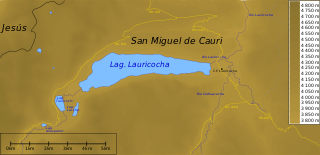
Arani is a province in Cochabamba Department, Bolivia. Its capital is Arani, situated about 53 km from Cochabamba. Arani is known for its bread and its artisan wickerwork.

Lake Lauricocha is a lake in the Andes mountains of central Peru, within Huánuco Region.

Lake Junin or Chinchaycocha is the largest lake entirely within Peruvian territory. Even though Lake Titicaca has a much larger area, its eastern half is located on Bolivian territory. Lake Junin is an important birdwatching destination in the country.
Ulcumayo is one of four districts of the Junín Province in Peru.

Pitumarca District is one of eight districts of the province Canchis in Peru.

Parqu Qucha is a Bolivian lake located in Vacas Municipality, Arani Province, Cochabamba Department.

Vacas Municipality is the second municipal section of the Arani Province in the Cochabamba Department in central Bolivia. Its capital is Vacas known as the "Land of the potato". During the Inca Empire Vacas served as a tampu along the Inca road system that led to Inkallaqta and Pocona.

Vacas is a Bolivian village in the southeast of the Cochabamba Department. It is the capital of the Vacas Municipality, the second municipal section of the Arani Province. Vacas is located about 85 km far from Cochabamba and about 30 km far from Arani.

Qullpa Qucha is a Bolivian lake located in Vacas Municipality, Arani Province, Cochabamba Department.

Asiru Qucha is a Bolivian lake located in the Vacas Municipality, Arani Province, Cochabamba Department.

The Ismael Montes Teacher Training College is an institution of public higher education under the authority of the Ministry of Education of Bolivia, also known as Normal de Vacas.

The Chanchamayo River is a river in the Junín Region in Peru. It originates in the Huaytapallana mountain range where it is named Tulumayu. Chanchamayo flows along the town of La Merced, which is also called Chanchamayo. After joining Paucartambo River, it is called Perené River.
Challwamayu is a river in Peru located in the Huancavelica Region, Huaytará Province, Pilpichaca District. It is an affluent of the Pampas River, the one which flows along the border of the Ayacucho and Huancavelica Regions. The confluence of the rivers is on the border of these regions, near Pukarumi (Pucarume). Challwamayu originates near the mountain Artisayuq (Artisayoc).
Challwamayu is a river in Peru located in the Junín Region, Satipo Province, Llaylla District.
Waqwaqucha is a lake in Peru located in the Cusco Region, Quispicanchi Province, Quiquijana District. Waqwaqucha is situated about 10 km northeast of the town Acomayo near the villages Waqwapata and Qucha K'uchu.
Kachimayu is a river in Peru located in the Cusco Region, Anta Province. It belongs to the Willkanuta watershed.

Matagaga is a mountain on the eastern extensions of the Cordillera Blanca in the Andes of Peru, about 4,400 metres (14,436 ft) high. It is situated in the Ancash Region, Huari Province, Chavin de Huantar District. Mata Qaqa lies east of the Rangracancha valley and northeast of the Challhua valley. The Mosna River flows along its northern slopes.
Challhuacocha is a lake in the Cusco Region in Peru. It is situated in the Calca Province, Pisac District.
Chullpa Ch'utu is a 3,748-metre-high (12,297 ft) mountain in the Bolivian Andes. It is located in the Cochabamba Department, Arani Province, Vacas Municipality, north of Vacas. The Jatun Mayu, a tributary of Parqu Qucha, flows along its western slope.
Iskay Wasi is a mountain in the Bolivian Andes which reaches a height of approximately 4,120 m (13,520 ft). It is located in the Cochabamba Department, at the border of the Arani Province, Vacas Municipality, and the Carrasco Province, Pocona Municipality. Iskay Wasi lies northeast of Qucha Quchayuq Urqu. The Iskay Wasi Mayu originates at the mountain. It flows to Misk'i Mayu.














